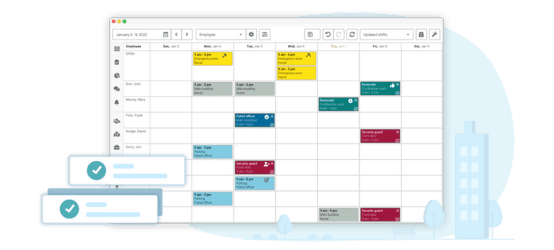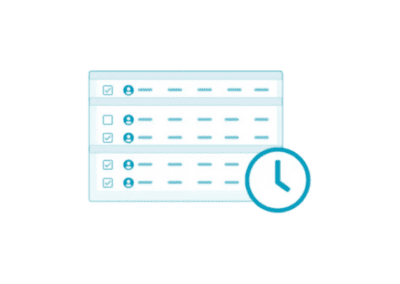In a restaurant, the staff schedule wields enormous authority. Front-of-house servers choose shifts with the highest tip potential. Back in the kitchen, the cooks must be at ease working the stations you’ve assigned them to, which isn’t always the case. Both groups require time off, and sick days and emergencies are unavoidable. Restaurant scheduling isn’t a piece of cake!

These concerns are exacerbated by the fact that, according to the National Restaurant Association, only roughly 44 percent of restaurant employees work full-time. This means that your employees are most likely managing numerous jobs and schedules. So how do you master restaurant scheduling? Taking this question further, how do you combat restaurant scheduling issues? In this blog, we’ll try to answer these questions and explain the role Celayix plays in helping restaurants with employee scheduling.
Common Restaurant Scheduling Issues
Employee dissatisfaction is widespread in the workplace, and disgruntled employees typically resign early. The most common cause of job unhappiness is scheduling concerns. So, how do these scheduling issues arise in the restaurant industry?

Understaffing
Your company’s productivity is determined by its staff. When your company is understaffed, your consumers suffer the most because there are no workers to serve them. Understaffing would also mean employees have to overwork, eventually leading to job burnout.
Unmonitored Shift Swapping
Allowing employees to determine their work schedules sounds nice because it relieves management of the burden of serving as the middleman. However, if you are not careful, this might lead to workplace instability and confusion. Shift swapping requires a transparent process with lines of communication open and effective collaboration. This may not necessarily always take place if shift swaps are unmonitored.

Overscheduling
If you’ve read our blog about overworked employees, you already know how over-scheduling can negatively impact any organization. Over-scheduling can significantly increase a company’s turnover rate, specifically in the restaurant industry. It’s important for managers that employees be punctual and bring higher energy to provide better services.
Lack of Organization
Every manager, especially those in the restaurant industry, should prioritize organization. However, keeping track of a long list of tasks and activities in a fast-paced industry might be difficult. Large restaurants often have hundreds of customers coming in at different hours and require sufficient employees to cater to each service aspect.
High Employee Turnover
Employee Turnover can occur due to reasons beyond a manager’s control. Nevertheless, if you know how to work with your employees, you can reduce employee turnover inside your business organization. Our blog on employee turnover talks a great deal about its causes and consequences, and it would be a great read if that’s something your organization goes through.
High Labor Costs

Tracking labour budgets in your company is vital and can help you stay on target. As a manager, you continuously look for the best method to use the company’s resources as efficiently as possible. However, with increasing wages and overtime pay, high labour costs could create severe problems for restaurants that are still trying to recover from the pandemic.
Now we will provide tips on how you can master this art of restaurant scheduling (and hopefully solve these issues)!
How to Master Restaurant Scheduling.
In case you’re new to the idea of restaurant scheduling, you should first take a look at the following pages:
- Understanding Automated Scheduling and Time & Attendance Software for Hospitality Services: Click Here
- Event Templates for the Restaurant Industry: Click Here
Once you have a basic idea of how restaurant scheduling is typically done, you will better understand how the following tips can help!

Hire the right employees for your needs
Not surprising, right? Employee scheduling issues are best avoided before someone becomes an actual employee. Hiring is the first step in your scheduling procedure.
Hiring, training, and retaining workers are the top three issues for restaurant operators, according to 36%. However, hiring is the foundation of that list because the wrong person needs more training and will eventually leave. And, before an employee leaves, you can observe how that trajectory affects restaurant scheduling in terms of absences and lateness.
So, first and foremost, you must hire the appropriate individuals. How?

- Know what you require. Before you know what to look for, you should know what you need. What levels of adaptability do you have? What shifts must you have covered at all costs? What are the deal breakers, and where can you make concessions?
- Discuss your expectations. It is best to be upfront about employment expectations during the hiring process. Even if you’re desperate for workers, you don’t lower your standards since anything less than upfront honesty and transparency is akin to deceiving someone into a job they won’t enjoy. Culture fit, their expectations, and your expectations must all be aligned. Make it clear what kind of work, attendance, and dependability you anticipate.
- Inquire about your scheduling choices. Find out what kind of work schedule they want, and make sure you know any limits, so there are no surprises later. Finding an excellent employee only to realize they are unavailable when you need them will not help.
- Look for self-motivated employees. Employees willing to work are not always easy to discover (or identify). Few employees would admit to being lazy, so you must ask open-ended questions to find out. Instead of asking if a potential employee is self-motivated, ask what they would do if they had completed their job and there were no clients around—it will build a more accurate image for you.
- Look for flexible employees. Find someone willing to accomplish a variety of tasks in a variety of shifts. The more willing prospective employees are to be flexible with their schedule and job, the easier it will be for you to construct the timetable. If an employee insists on solely being the host, yet you also need someone to bus tables, that’s not enough flexibility.

A flexible employee is the most valuable asset in a changing labour market with ongoing scheduling issues.
Provide Restaurant Schedules in Advance
“Sooner begun is sooner done.”
Providing a timetable ahead of time shows respect for your personnel. It also helps to prevent last-minute worry because everyone has enough time to juggle things around a little.
Employees are less likely to be absent when they have time to obtain daycare, make appointments, and plan vacations. Consistency in how and when the schedule is created and released offers employees a sense of security and authority since they can better organize and regulate their personal lives. Still not persuaded?
As employees resisted last-minute or on-call scheduling, predictive scheduling laws have become more common in recent years. You can’t budget your income if it isn’t consistent, and you can’t budget (plan) your life if your job schedule is erratic and last-minute. Waiting till the last minute with your schedule is not only unpleasant, but it is also perhaps unlawful.

Communicate with Employees
Expectations shift as the times change. Policies, procedures, and the lives of employees all change. However, until these modifications are disclosed, no one is aware of them. Communication is never one-time; it is constantly continuous, beginning with job interviews and continuing forth.
When business is challenging, and the labour scarcity is affecting you, communicate with your staff about what’s going on and how it’s affecting the schedule, rather than simply presenting chaotic schedules with changes or shifts they don’t understand. It’s conceivable that they’ll have some helpful input or recommendations for you.
Of course, communication is interdependent. Have you ever asked your shift manager how your restaurant’s schedule is going? Most managers would probably mention one of the issues discussed earlier (a special mention of unmonitored shift swapping). Employees must be able to quickly communicate with you about changes in their lives that may interfere with the work schedule. Even the most minor obstacle prevents some employees from speaking with you.

The most important thing you can do for yourself is to reduce the friction in your communication routes. More channels aren’t necessarily better. Allowing email, text, phone calls, and messaging services are more confusing than helpful. It is essential to have a straightforward communication plan with a go-to tool that is simple for them to use and simple for you to utilize.
You should be able to communicate swiftly with your entire team, subgroups, and individuals. Employees must be able to share with you about scheduling problems. They must speak discreetly with other employees regarding the schedule, switching shifts, and whatever else comes up (without disclosing their phone number). BTW This is possible with Celayix!
Prioritize shifts
Remember the following:
- Busy shifts come first!
- Equal Earning Opportunities
- Be considerate.
Plan your busiest shifts first.

Managers must fill the busiest shifts, so make sure they are. Then you may focus on the rest. Because the dynamic shift is when restaurant employees earn the highest tips (depending on their employment) and work the hardest, be sure you give this shift to all employees equally.
Perhaps they’ll switch it. Maybe they’ll tell you they don’t want it. However, because the busier shift has the most significant money, you arrange and offer it first. After it is done, remember to be compassionate.
We recognize that constructing a restaurant schedule is complex and considerably more difficult in today’s labour market. But don’t allow your desperation to drive you to do things that may harm employee retention in the long run. Remember that your objectives and the priorities of your workers aren’t always the same, and if you want to retain staff, you need to consider what they need and desire.
For example, your desire to get the most uninterrupted work out of your team may lead you to believe that having staff arrive early to take breaks before you need them to work is a fantastic idea. It will irritate your staff.

What else do employees despise?
The clopening shift. That merely wears your staff down, and they will ultimately quit. Avoid booking one day off at a time if feasible; two days off in a row allows employees to enjoy their time off genuinely. Some jurisdictions have rules that ban questionable scheduling practices, but just because your state doesn’t mean you should.
In reality, the simplest way to avoid doing this, even unwittingly, is to adopt restaurant scheduling software that gives staff power and communication back. People may be more inclined to work unpopular shifts if they have a choice.
That brings us to our final point, which is about employing the proper scheduling tools.
Data and Technology: Use the right software
You can see how the preceding advice leads to the same conclusion: use the correct technology. Because your time is precious, scheduling staff should not require you to reinvent the wheel every time. You can do the most incredible thing by ditching pen and paper and spreadsheets in favour of superb restaurant scheduling software.

First, establish a scheduling habit (same day, same hour, etc.) to organize your time better and let your staff know when to anticipate the following schedule (this is part of scheduling in advance). Then, utilize scheduling software with automated functions to create schedules more quickly and intelligently. Celayix makes it simple to establish templates that allow you to specify shifts so that they can be auto-populated and you can be confident that you have the proper coverage based on data.
Celayix provides flexible tools such as self-scheduling and shift-bidding for employees too. These solutions enable employees to quickly claim or switch shifts with one another without bothering you, all within the parameters you set.
Celayix AI uses machine learning to analyze your prior schedules to offer the best shift assignments for your schedule. You don’t have to do anything because Celayix’s AI technology is entirely automated! Celayix will do the rest if you ask it to fill a new schedule or find a substitute. For anyone that’s dealing with restaurant scheduling issues, Celayix can help you overcome them. Contact us if you need help mastering restaurant Scheduling!





